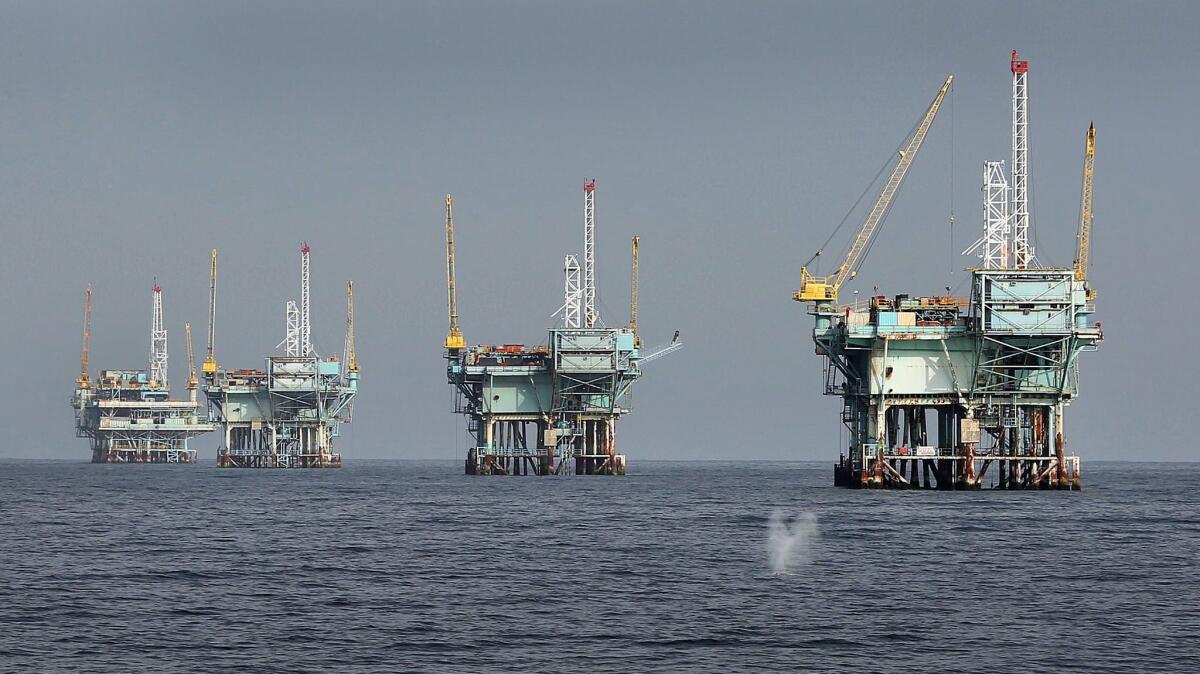Trump’s plan to open California coastal waters to new oil and gas drilling probably won’t go very far

There are two things working against the Trump administration’s proposal to open up California coastal waters to new oil and gas drilling: state regulators and simple economics.
California has powerful legal tools to head off new offshore development, and the price of oil offers little incentive to the energy industry to pursue expensive drilling projects next to a hostile state.
“I don’t think there’s any reasonable chance that there will be any leasing or drilling along the coast,” said Ralph Faust, former general counsel for the California Coastal Commission. “This just seems like grandstanding” by the Trump administration.
The Interior Department on Thursday released plans to open vast areas off the Atlantic and Pacific coasts to new oil and gas exploration and drilling through a five-year leasing program that would begin in 2019.
But there are myriad obstacles opponents can throw in front of the proposal, not to mention questions about whether the oil industry has much of an interest in California’s offshore reserves at a time when domestic oil production is at its highest level in decades.
Under the plan, the federal government would offer 47 leases in U.S. waters on the outer continental shelf, including two each off the Northern, Central and Southern California coasts and one off Washington and Oregon.
The governors of all three states issued a joint statement Thursday saying they would do whatever it takes to block new leasing off their shores, which include some of the nation’s most pristine coastlines.
The first hurdle for the Trump plan is a period of public comment and an extensive environmental review under federal law, which opponents can use to challenge the proposal as ecologically harmful.
In California, the state coastal commission also has the authority to review activities in federal waters to ensure they are consistent with the state’s coastal management plans.
“The commission has extremely broad and very powerful authority to say ‘no’ to federal actions that would harm the coast of California and harm coastal waters,” said Steve Mashuda, an attorney at Earthjustice, a nonprofit environmental law organization.
The commission is ready to use it.
“Nothing galvanizes bi-partisan resistance in California like the threat of more offshore oil drilling,” coastal commission Chairwoman Dayna Bochco said in a statement. “We’ve fought similar efforts before, and we will fight them again.”
While the U.S. Secretary of Commerce could override a commission finding that new oil drilling violated the state’s management plan, federal courts have tended to side with states in such contests.
And California has another weapon: State Lands Commission jurisdiction over tidelands and waters that extend roughly three miles offshore.
That gives the commission the ability to stop the construction of pipelines that are the most economical way of transporting oil and gas from offshore rigs to land.
“In some ways that is an even more formidable tool that the state of California and like-minded local governments can utilize to deny approval of things like oil terminals and pipelines crossing state sovereign tidelands,” said Richard Frank, director of the California Environmental Law & Policy Center at UC Davis.
There are 23 oil platforms in federal waters off California and four in state waters — near Santa Barbara County, Huntington Beach and Seal Beach. There are also four artificial islands used as drilling platforms off Long Beach and one off Rincon Beach in Ventura County.
But images of oil-drenched sea birds and fouled beaches during the massive 1969 Santa Barbara oil spill soured the state on offshore oil development. There have been no new federal leases off California since 1984.
Moreover, uncertainty over prices makes costly new drilling projects in California’s deep offshore waters difficult to justify financially compared with cheaper hydraulic fracturing operations on land.
Oil is trading at about $60 a barrel — roughly the price that would make an offshore project profitable, said Peter Maniloff, an economist at Colorado School of Mines who studies the oil and gas industry.
But “you want to be confident that prices will remain that high before undertaking a very large investment to drill an offshore well,” Maniloff said. “And it’s hard to be confident of that because fracking has driven prices down.”
“This announcement is not a game changer for the oil industry or for California,” he added. “I would not expect substantial drilling or production off California.”
Michael Livermore, an environmental law professor at the University of Virginia, said that “based entirely on the Department of Interior’s own analysis, drilling off the coast of California is a terrible idea.”
He cited a section of the leasing proposal that found waters off Central California did not meet the government threshold for benefits exceeding the costs of oil drilling. “Waiting in the region could provide greater value to society than leasing in the 2019–2024 Program,” according to the report.
Livermore also questioned whether any company would be willing to risk the public backlash were there to be a spill in such closely watched waters.
David Hackett, an oil industry expert and president of Stillwater Associates, an Irvine-based transportation energy consulting firm, supports more oil development off the California’s coast.
But given fierce state and local opposition, he doubts new oil rigs will start popping up in the Pacific.
“Even if California was supportive, it would take a decade for production to begin,” he said.
More to Read
Sign up for Essential California
The most important California stories and recommendations in your inbox every morning.
You may occasionally receive promotional content from the Los Angeles Times.












